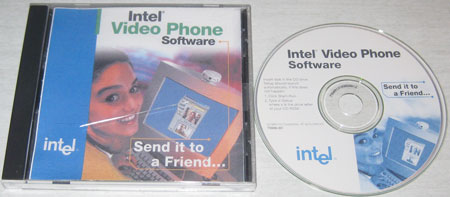Remember Intel’s custom flavor of H.263 cleverly named I.263? I think I have finally found an application that used it thanks to a recent thrift shop raid— Intel Video Phone:

The root directory of the disc has 2 copies of an intro.avi video. One copy uses Intel Indeo 3 video and PCM audio. The other uses I.263 video and an undetermined (presumably Intel-proprietary) audio codec — RIFF id 0x0402 at a bitrate of 88 kbits/sec for stereo, 22 kHz audio. The latter video looks awful but is significantly smaller (like 4 MB vs. 25 MB).
This is the disc marked as “Send it to a friend…”. Here’s the way this concept was supposed to operate:
- You buy an Intel Video Phone Camera Pack (forgotten page courtesy of the Internet Archive) which includes a camera and 2 CDs.
- You install the camera and video phone software on your computer.
- You send the other CD to the person whom you want to be able to see your face when you’re teleconferencing with them.
- The other party installs the software.
- The 2 of you may make an internet phone call presumably using commodity PC microphones for the voice component; the person who doesn’t have a camera is able to see the person who does have a camera.
- In a cunning viral/network marketing strategy, Intel encourages the other party to buy the physical hardware as well so that they may broadcast their own visage back to the other person.
If you need further explanation, the intro lady does a great job:
I suspect I.263 was the video codec driving this since Indeo 3 would probably be inappropriate for real time video applications due to its vector quantizing algorithm.
According to http://wiki.multimedia.cx/index.php?title=Twocc :
0x0402 Ligos Indeo Audio
Makes sense.
Thanks, I was too lazy to look that up. I just know it didn’t play in VLC.
@Mike She mentions video camera games in the video. What are they like?
@Peter: To be honest, I hadn’t watched that far in the video to notice the bit about games. So, good question. I don’t see any obvious references on the CD-ROM that would indicate games. I guess this would make sense considering that this is the “send to friend” version of the software, so it assumes the recipient doesn’t have the camera hardware.
I tried to install the software but the installer bails, claiming that I don’t have the right version of Windows (even when I set Windows 7 compatibility back to Windows 98 for the SETUP.EXE file).
Is it 64 bit Windows? It can’t run 16 bit executables and that one almost certainly still is a 16 bit installer.
@Reimar: Good point. This is, in fact, 64-bit Windows 7. However, I wouldn’t expect Windows software from 1999 to be 16-bit.
The software itself isn’t, but the major commercial installers all used 16-bit components to my knowledge even some time after 2000. X-Wing Alliance from October 2000 is just one example.
Which is why it’s so ridiculous that some people try to fool people into believing that 64 bit versions have no disadvantage when in reality it means you can forget about installing a lot of stuff older than 10 years and probably even some stuff that is 5-6 years old.
InstallShield never felt it necessary to upgrade their 16-bit installation library (I believe the frontend was 32-bit by 2000). Why should they when all the Intel processors still supported it as did Win32?
(Also, X-Wing Alliance was February 1999, not October 2000 ;))
Well that changes everything. Good thing I still have a little WinXP box laying around for the oldest games in my collection. I guess I won’t be getting rid of it after all.
i dont remember winxp being able to run 16bit stuff either. even win2k cant run the 16bit vfw codecs.
sorry, i think you have to go back to win95/win98 for that.
someone even made a guide for creating a virtualpc/vmware win9x box to install old codecs. for people to transcode their old video files into a new format.
http://www.moviecodec.com/video-codecs/help-with-aura-1-codec-61030/
i use uniextract to extract files from installers. it works sometimes.
http://legroom.net/software/uniextract
@compn: The codec should be a 32-bit one if it’s from 1999. Of course, if you installed the old Video for Windows in Windows XP, it should still be able to use the 16-bit codecs (provided you have the 32-bit version of WinXP). I know it works because I’m able to play Buried in Time (Win16) through the VfW code.
Just a curious historical note, but the data book documenting the Intel 82750DB (Display Processor) and Intel 82750PB (Pixel Processor), both together being the (in?)famous i750 multimedia accelerator chipset, has just been put up on bitsavers.
For those unfamiliar with it, the Indeo video was basically built to run on this programmable video processor.
You can find the datasheets for both chips in the Intel Multimedia and Supercomputer Processors databook, circa 1992:
http://www.bitsavers.org/pdf/intel/_dataBooks/Intel_Multimedia_and_Supercomputing_Processors_Jan92.pdf
The book also documents the i860 “Cray killer” CPU (which ended up in lots of early 3D hardware), and the i960 RISC chip (which is remarkably elegant for an Intel design).
Even the 32-bit version of Windows 7 runs 16-bit code just fine.
The problem is the 64-bit versions, since the CPU in long mode no longer supports 16-bit code execution and Microsoft obviously didn’t want to write an emulator to run it.
However it seems they provided stubs for some of the InstallShield DLLs, so version 4 and 5 should still be working despite the original code using 16-bit code.
XWA sure doesn’t though (though someone built an MSI installer for it).
For those with a Win7 Professional version they can run the XP VM you can get for free with it.